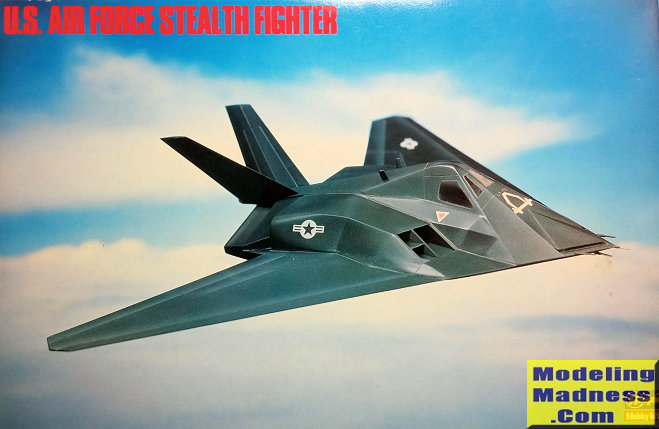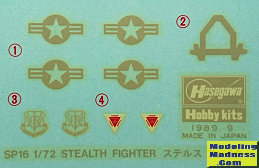
Hasegawa 1/72 F-117 Stealth Fighter
| KIT #: | 51516 (SP 16) |
| PRICE: | $12.00 |
| DECALS: | One option |
| REVIEWER: | Spiros Pendedekas |
| NOTES: | Initial 'inaccurate shape' tooling |

| HISTORY |
The Lockheed F-117 Nighthawk is a retired American single-seat, subsonic twin-engine stealth attack aircraft solely operated by the USAF. It was the first operational aircraft to be designed with stealth technology. The project was started during the 70s, with deliveries beginning during the early 80s.
A secret project by all means, it was publicized during the 1991 Gulf War. It also took part in the early 90s Yugoslavia conflict, Operation Enduring Freedom in 2001 and Operation Iraqi Freedom in 2003. The type was retired in 2008, with a portion of the fl3et being kept in airworthy condition. A total of 64 examples (including 5 prototypes) were built.
| THE KIT |
 The
F-117 (initially called as “F-19” in late 80s news articles) was a secret
project, with only a grainy photo appearing on 10 November 1988, during a press
conference of Assistant Secretary of Defense J. Daniel Howard. Needless to say,
by that time, many scale modeling companies wanted to present their Stealth
Fighter as early as possible. With only scarce information available, it was
very interesting to see a number of new toolings during the late 90s that bore
little resemblance to the real thing. One of them was the 1989 Hasegawa initial
tooling, the subject of this preview, which is not to be confused with the
company’s 1999 follow-up very accurate tooling.
The
F-117 (initially called as “F-19” in late 80s news articles) was a secret
project, with only a grainy photo appearing on 10 November 1988, during a press
conference of Assistant Secretary of Defense J. Daniel Howard. Needless to say,
by that time, many scale modeling companies wanted to present their Stealth
Fighter as early as possible. With only scarce information available, it was
very interesting to see a number of new toolings during the late 90s that bore
little resemblance to the real thing. One of them was the 1989 Hasegawa initial
tooling, the subject of this preview, which is not to be confused with the
company’s 1999 follow-up very accurate tooling.
The specific kit was bought brand new in 2024 from an Athens shop at a good price and comes in a relatively small sized, high quality, top opening box, with the boxart featuring a photo of a finished model.
Upon opening the box, I was greeted with just 13 black styrene parts arranged in two equally sized spues. Apart from the kit’s overall simplicity (not even landing gear is provided, as the model can only be built in wheels-up configuration), what becomes immediately apparent is that the model bares little resemblance to the real thing, coming closer to a sort of an eggplane.
Nevertheless, molding is nice and crisp and panel lines are engraved. The fuselage is split horizontally, while all aerodynamic surfaces are one-piece. The intake faces are grossly unrefined. Neither cockpit nor landing gear is provided, as the model can only be built “wheels-up”. At least, a nice base is provided.
The one piece canopy is tinted, so there is some chance to hide the cockpit’s non-existence. Instructions are nicely done in the typical Hasegawa pamphlet style, including a sort of introductory historical text, a sprues map, a color chart, with the simplistic construction spread in seven clear and concise steps.
 Only one
generic black scheme is provided. Decals have yellowed a bit, but otherwise are
nicely printed and seem to be in usable condition.
Only one
generic black scheme is provided. Decals have yellowed a bit, but otherwise are
nicely printed and seem to be in usable condition.
Instructions want you to first attach the canopy from the top fuselage innards, then join the fuselage halves, followed by attaching the intakes, wings, ruddervators and some sort of antennas, ending an ultra simplistic build.
| CONCLUSIONS |
Clearly, this model cannot stand as an accurate representation of the F-117 and the fact that Hasegawa came in 1999 with a very nice and accurate tooling says it all. The specific kit can only be viewed as a sort of a walk down memory lane, where kit manufacturers felt that they should go for a kit of a subject that had little information about. That said, there’s really nothing wrong in building such a kit, with its simplicity of construction deeming it suitable even for a toddler’s first attempt.
Apparently, this kit is gradually becoming a collector’s item, with its availability declining and its prices interestingly rising.
Happy Modeling!
Spiros Pendedekas
November 2024
Copyright ModelingMadness.com. All rights reserved. No reproduction in part or in whole without express permission.
If you would like your product reviewed fairly and fairly quickly, please contact the editor or see other details in the Note to Contributors.